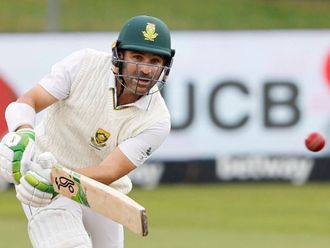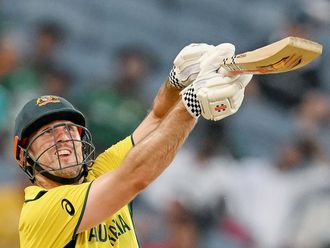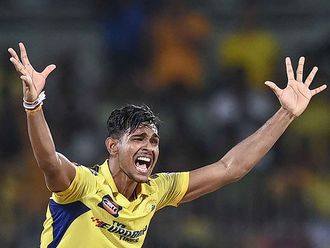Dubai: Do India, defending champions of the World Cup, have a bowling attack strong enough to defend the title? A look at the recent performances of their bowlers reveal that it is a wafer-thin attack.
So weak has been their bowling that the question in everyone’s mind is whether this bowling attack will be able to defend even a total of 300-plus during the World Cup?
India’s bowling standards had been deteriorating steadily and have now reached a stage where no one in the line-up can be called a match-winner. No one looks capable of creating any fear in the opposing batsmen and no team is going to look forward with trepidation for a bowler to complete his quota of overs.
Ishant Sharma, who leads the Indian attack, is the most experienced among the bunch, though he is yet to produce a five-wicket spell and has only five four-wicket spells in his 76 One Day Internationals.
With Zaheer Khan, the most respected among the Indian bowlers being ignored for the World Cup, the rest of the bowlers in the team does not pose any threat. Though Bhuvneshwar Kumar began with a lot of promise his bowling now looks ordinary and his slowing pace has raised questions over his fitness. Umesh Yadav and Mohammad Shami have been quick in patches but hardly consistent.
No need for sleeping pills
Stuart Binny, who was picked for his all-round skills, now looks the most effective among all the bowlers but as Ian Chappell pointed out in his inimitable style: “Opening bowlers Binny or Kumar are not going to have the opposition batsmen searching for sleeping pills. Binny as an allrounder can provide some runs and bowl a few economical overs, but certainly not a new-ball bowler.”
This brings us to the question whether the spinners Ravichandran Ashwin or Ravindra Jadeja can wreck the opposition? The last time Ashwin took the highest number of wickets in an innings was his three-wicket spell against England in August 2014. In the last seven one-dayers he played, he has taken two wickets just twice. Jadeja is not only struggling for form but also fitness.
India tried out a few medium pacers notably Varun Aaron, who was disappointing in Australian wickets. He has the pace but lacks control while Dhawal Kulkarni and Ashok Dinda have not inspired enough confidence. Overall, the bowling strength in the whole country looks gloomy.
Indian selectors have ignored Harbhajan Singh and Zaheer Khan based on their current form but it is important for the Board of Control for Cricket in India (BCCI) to find out why bowlers like the above two who could run through batting line ups are not emerging.
One view is that most young cricketers in the country want to become batsmen. This is being attributed to the impact created by Sachin Tendulkar and Rahul Dravid. Almost all young cricketers want to emulate Tendulkar and not any Indian bowler. In fact, after Kapil Dev retired, there hasn’t been a bowler whom any youngster would want to emulate.
No pace in wickets
The BCCI, despite having a Grounds Committee which is supposed to look at the quality of wickets in India, hasn’t bothered to create any fast wickets. The fear that foreign teams would perform better with their pacers during a home series is the main reason. It is high time they realised that their team will not be able to remain at the top of the rankings by only winning on home wickets. Slipping down the ranking in Tests, India has reached the seventh positon with only West Indies, Bangladesh and Zimbabwe below them.
As long as India live in make-believe world that match winners will spring up automatically, their bowling strength will remain weak. Even spin which was India’s strength has become so weak that spinners of other countries are looking better. Legendary spinners like Bishen Singh Bedi and Erapalli Prasanna are not even considered as consultants to shape spinners. Even Kapil Dev has been ignored to groom pacers.
If Indian bowlers do not win matches in the World Cup, the BCCI must take the sole responsibility and admit they have failed because of their refusal to change with the times and their adamant stand of not changing the wickets and consulting the greats of the game in their own country.
Meanwhile, India’s MRF Pace Foundation has shaped some of the best fast bowlers in the world.
Legendary Australian pacer Dennis Lillee and former Indian pacer T.A. Sekar did remarkable work producing match-winners, with Australian bowlers Glenn McGrath, Brett Lee and Mitchell Johnson sharpening their skills at this foundation, which existed in Chennai.
The BCCI never considered it good enough to seek Sekar’s advice in shaping pacers though he, along with Lillee, was instrumental in making Zaheer Khan, Irfan Pathan, Munaf Patel and Shantakumaran Sreesanth, who has been banned from cricket following the Indian Premier League match-fixing scandal, as effective bowlers.
Once when Gulf News asked Sekar why Indian pacers are no longer effective, he said: “Technical flaws are bound to creep into any bowler who plays a lot of matches. Unfortunately there aren’t capable persons to monitor such flaws.”












